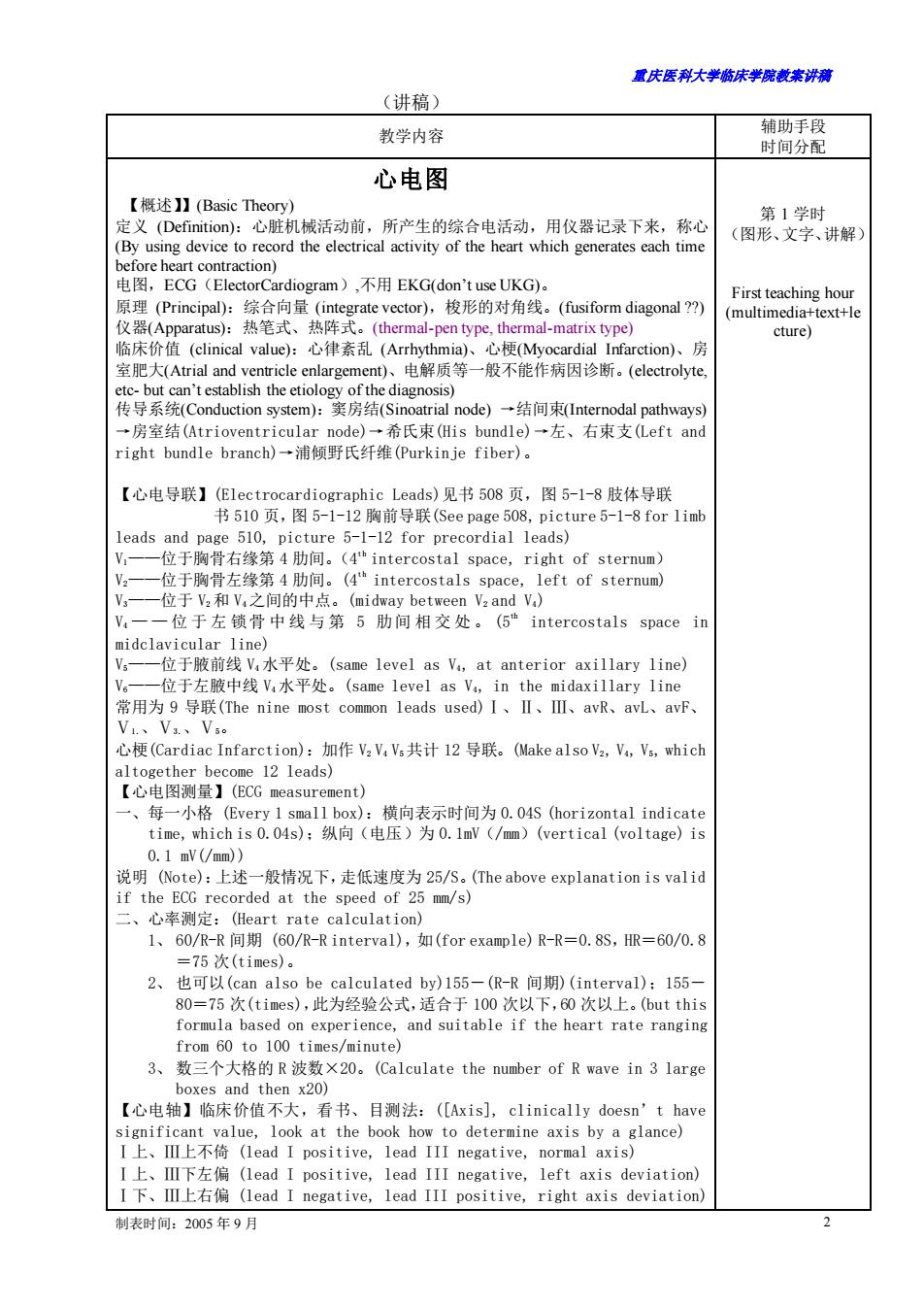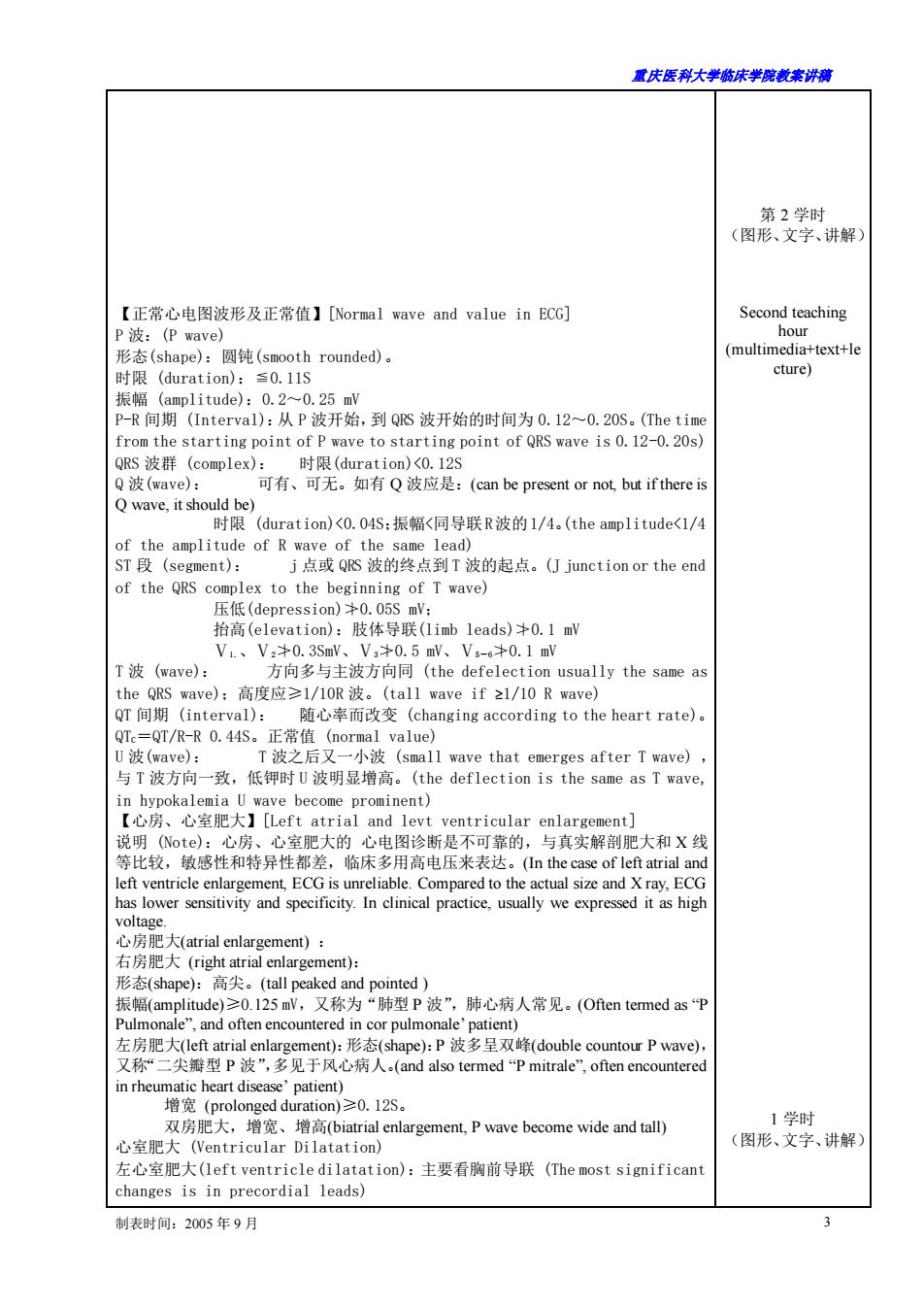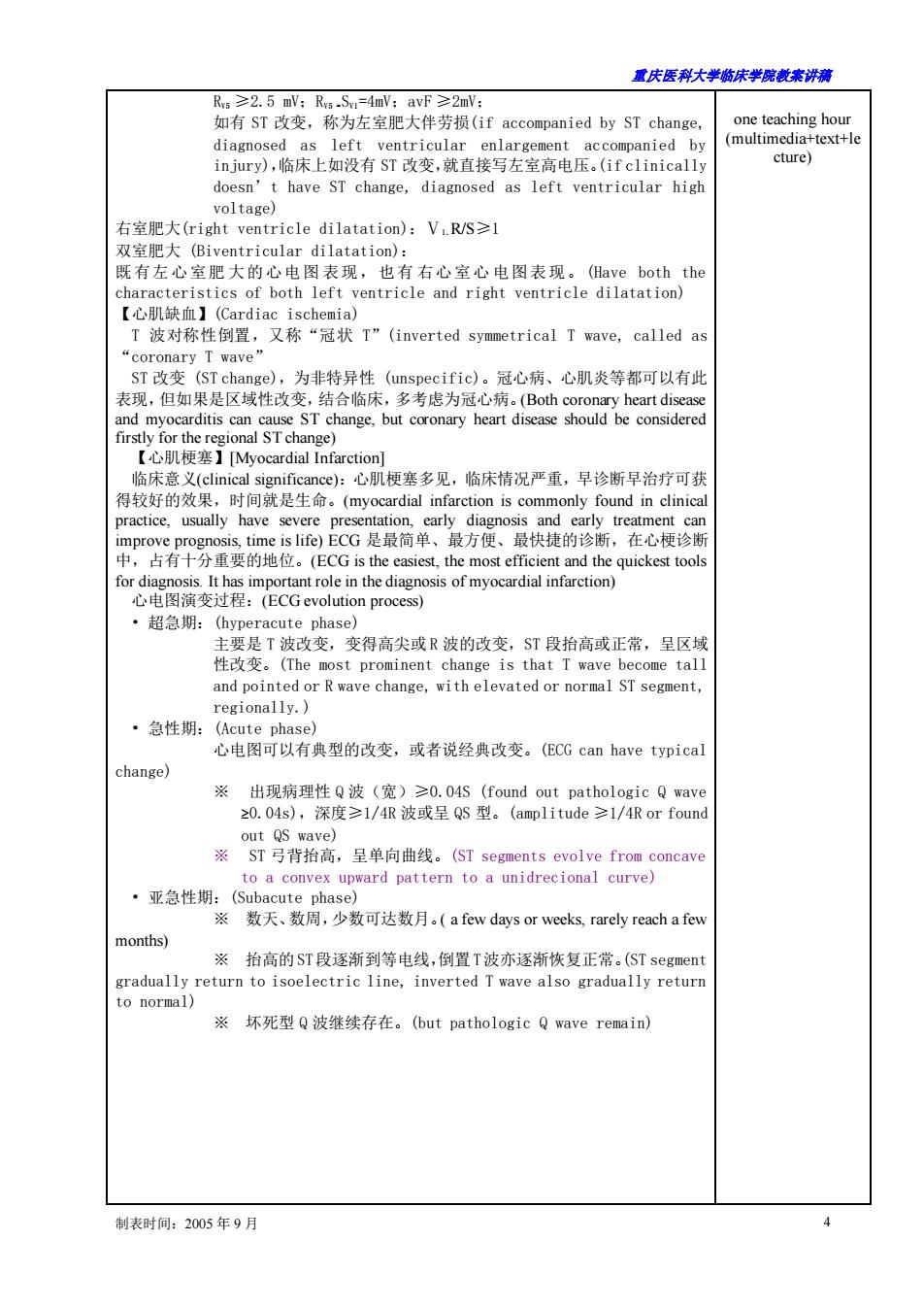
重庆医科大学脑床学院载未讲满 重庆医科大学临床学院教案及讲稿 (教案) 课程名称诊断学 年级2005级 授课专业临床医学 教师雷寒 职称教授 授课方式大课 学时6 题目章节心电图检查 教材名称诊断学 作者吕卓人雷寒 出版社科学出版社 版次第一版 目的要 了解心电图的重要性、临床价值、心电图的基本知识、正常心电图的特点、各 难 教学 常见心律素乱、常见心律紊乱的心电图特点(三种早搏、心房颜动、房、结、室心动过速、时 颜)传导阻滞、心肌梗塞的演变、心肌梗塞的心电图分类。 ECG characteris 点 r conduction bloEGchamgenartionE classification of myocardial infarction 外语 掌握基本专业术语 教学 多媒体图形+文字+讲解(mutimedia+text+-lecture) 各版的诊断学,比如此6版P534,图5一1一46可以认为是错误的,必须给学生说明 such as 6 edition page 534 picture 5-1-46 is not correct and should b 教研 见 制表时间:2005年9月
重庆医科大学临床学院教案讲稿 制表时间:2005 年 9 月 1 重庆医科大学临床学院教案及讲稿 ( 教 案 ) 课程名称 诊断学 年级 2005 级 授课专业 临床医学 教 师 雷寒 职称 教授 授课方式 大课 学时 6 题目章节 心电图检查 教材名称 诊断学 作者 吕卓人 雷寒 出 版 社 科学出版社 版次 第一版 教 学 目 的 要 求 诊断学阶段、了解心电图的重要性、临床价值、心电图的基本知识、正常心电图的特点、各种 心律紊乱的心电图特点等。(Understand the importance, clinical value, and basic knowledge of ECG. Understand the characteristic of normal ECG, arrhythmia, etc) 教 学 难 点 具体的数据和心电图特点、常见心律紊乱心电图的特点。(Data and characteristic of ECG, ECG characteristic of common found arrhythmia) 教 学 重 点 常见心律紊乱、常见心律紊乱的心电图特点(三种早搏、心房颤动、房、结、室心动过速、时 颤)传导阻滞、心肌梗塞的演变、心肌梗塞的心电图分类。(Common arrhythmia, ECG characteristic of common arrhythmia (Three types premature complex, Atrial fibrillation, Atrial, Junctional, ventricle tachycardia, ventricle fibrillation), conduction block, ECG change of myocardial infarction, ECG classification of myocardial infarction 外语 要求 掌握基本专业术语 教学 方法 手段 多媒体图形+文字+讲解 (multimedia+text+lecture) 参考 资料 各版的诊断学,比如此 6 版 P534,图 5-1-46 可以认为是错误的,必须给学生说明。 Diagnostics textbook, such as 6th edition page 534 picture 5-1-46 is not correct and should be explained to student 教研 室意 见

营庆医科大半脑床半院载来沙满 (讲稿) 教学内容 铺助毛段 时间分配 心电图 【概述】(Basic Theory) 心脏机械活动前,所产生的综合电活动,用仪器记录下来,称心 第1学时 (By using device to record the electrical activity of the heart which generates ach time (图形、文字、讲解 ),不用EKG((don'useUKG) First teaching hou (multimediatex 临床价信aa: 心律紊乱(A -pen type. -matrix type) cture) 肥大Atri t-but can'testablish the etiology of the diagnosis) 传导系统(Conduction system):窦房结(Sinoatrial node)一结间束Internodal pathways) 一房室结(Atrioventricular node) 希氏束(His bundle)→左、右束支(Left and right bundle branch)→浦倾野氏纤维(Purkinje fiber)。 【心电导联】(E1e 联6见书508页,图5肢体联邮 前导联(S eads and。 510 5- -12fo dial ight of ster num) -位于胸骨左缘第4肋间。(4"intercostals space,left of sterne m) 一位于V和V,之间的中点。(midway between V2andV,) -位于左锁骨中线与第5肋间相交处。(5 intercostals space in midclavicular line) 一位于腋前线V水平处。 (same level as V,at anterior axillary line) 位于左腋中线V,水平处。(same level as in the midaxillary line 落用为g导联(The nine ost common1 eds used))、I、avR、avL、aF、 Infarc tion):加作2V,V,共计l2导联。(Make also Va,V,V,hic ant 、每小格(Every1 small box):横向表示时间为0.04S(horizontal indicate time,which is0.04s):纵向(电压)为0.1mW(/m)(vertical(voltage)is 0.1mN(/mm)) 说明(Note):上述一般情况下,走低速度为25/S。(The above explanation is valid if the ECG recorded at the speed of 25 mm/s) 二、心率测定:(Heart rate calculation) 1、60/R-R间期(60/R-R interval),如(for example))R-R=0.8S,HR=60/0.8 2、 calcul ated by)155-(R-R间期)(interval):15 d on the he from 60 to 100 time 3、数三个大格的R波数×20。(Calculate the number of R wave in3larg hoxes and then x20) 【心电轴】临床价值不大,看书、目测法:([Axis],clinically doesn'thav significant value,look at the book how to determine axis by a glance) I上、Ⅲ上不倚(1 ead I positive,.lead III negative,normal axis) I上、Ⅲ下左偏(lead I positive,lead III negative,.left axis deviation)) I下、m上右偏(lead I negative,lead III positive,right axis deviation)) 制表时间:2005年9月
重庆医科大学临床学院教案讲稿 制表时间:2005 年 9 月 2 (讲稿) 教学内容 辅助手段 时间分配 心电图 【概述】】(Basic Theory) 定义 (Definition):心脏机械活动前,所产生的综合电活动,用仪器记录下来,称心 (By using device to record the electrical activity of the heart which generates each time before heart contraction) 电图,ECG(ElectorCardiogram),不用 EKG(don’t use UKG)。 原理 (Principal):综合向量 (integrate vector),梭形的对角线。(fusiform diagonal ??) 仪器(Apparatus):热笔式、热阵式。(thermal-pen type, thermal-matrix type) 临床价值 (clinical value):心律紊乱 (Arrhythmia)、心梗(Myocardial Infarction)、房 室肥大(Atrial and ventricle enlargement)、电解质等一般不能作病因诊断。(electrolyte, etc- but can’t establish the etiology of the diagnosis) 传导系统(Conduction system):窦房结(Sinoatrial node) →结间束(Internodal pathways) →房室结(Atrioventricular node)→希氏束(His bundle)→左、右束支(Left and right bundle branch)→浦倾野氏纤维(Purkinje fiber)。 【心电导联】(Electrocardiographic Leads)见书 508 页,图 5-1-8 肢体导联 书 510 页,图 5-1-12 胸前导联(See page 508, picture 5-1-8 for limb leads and page 510, picture 5-1-12 for precordial leads) V1——位于胸骨右缘第 4 肋间。(4 th intercostal space, right of sternum) V2——位于胸骨左缘第 4 肋间。(4th intercostals space, left of sternum) V3——位于 V2 和 V4 之间的中点。(midway between V2 and V4) V4 — — 位 于 左 锁骨 中 线 与 第 5 肋间 相 交 处 。 (5th intercostals space in midclavicular line) V5——位于腋前线 V4 水平处。(same level as V4, at anterior axillary line) V6——位于左腋中线 V4 水平处。(same level as V4, in the midaxillary line 常用为 9 导联(The nine most common leads used)Ⅰ、Ⅱ、Ⅲ、avR、avL、avF、 Ⅴ1.、Ⅴ3.、Ⅴ5。 心梗(Cardiac Infarction):加作 V2 V4 V5 共计 12 导联。(Make also V2, V4, V5, which altogether become 12 leads) 【心电图测量】(ECG measurement) 一、每一小格 (Every 1 small box):横向表示时间为 0.04S (horizontal indicate time, which is 0.04s);纵向(电压)为 0.1mV(/mm)(vertical (voltage) is 0.1 mV(/mm)) 说明 (Note):上述一般情况下,走低速度为 25/S。(The above explanation is valid if the ECG recorded at the speed of 25 mm/s) 二、心率测定:(Heart rate calculation) 1、 60/R-R 间期 (60/R-R interval),如(for example) R-R=0.8S,HR=60/0.8 =75 次(times)。 2、 也可以(can also be calculated by)155-(R-R 间期)(interval);155- 80=75 次(times),此为经验公式,适合于 100 次以下,60 次以上。(but this formula based on experience, and suitable if the heart rate ranging from 60 to 100 times/minute) 3、 数三个大格的 R 波数×20。(Calculate the number of R wave in 3 large boxes and then x20) 【心电轴】临床价值不大,看书、目测法:([Axis], clinically doesn’t have significant value, look at the book how to determine axis by a glance) Ⅰ上、Ⅲ上不倚 (lead I positive, lead III negative, normal axis) Ⅰ上、Ⅲ下左偏 (lead I positive, lead III negative, left axis deviation) Ⅰ下、Ⅲ上右偏 (lead I negative, lead III positive, right axis deviation) 第 1 学时 (图形、文字、讲解) First teaching hour (multimedia+text+le cture)

重庆医科大半脑床半院载未讲满 第2学时 (图形、文字、讲解 【正常心电图波形及正常值】[Normal wave and value in ECG] Second teaching Pp波:(p wave) 形态(shape):圆钝(smooth rounded)。 text+le 时限(duration):≤0.1 0.25mV R间期(Interval): from the starting point of P wave to starting point of QRS wave is 0.12-0.20s) (can be present or not but ifthere is Qwave,it should be) 时限(duration),<0.04S:振幅<同导联R波的1/4.(the amplitude<1/4 of the amplitude of R wave of the same lead) ST段(segment): j点或Qs波的终点到T波的起点。(J junction or the end of the QRS complex to the beginning of T wave) 压低(depression)0,05sm evat leads)0.1 m m T波(wave) 向多与主波方5。出0 ave):高度应≥1/1OR波】 usually the same as (ta11 ve if 21/10 Rw QT间期(inte a1 随心率而改变(changing accc rding to the heart rate) qTc=qT/R-R0.445。正常值(normal value) I波(wawe). r波之后又一小波(small wave that emerges after T wave) 与T波方向一致,低钾时U波明显增高。(the deflection is the same as T wave in hypokalemia U wave become prominent) 【心房、心室e大】[Left atrial and levt ventricular enlargement] 图诊断是 可靠的,与真实解剖肥大和X线 电压来 (In th 态(shape) rgement): ed P波”,肺心病人常见。(Often termed as"P tient) 左房肥大(left atrial enlargement):形态(shape):P波多呈双峰(double countour P wave), 又称“二尖瓣型P波”,多见于风心病人.(and also termed"P mitrale”,often encountered dise ase patient) 0.12S 心室肥大 largement,P wave become wide and tall) 左心室肥大(eft ventricle dilatation):主要看胸前导联(The most significan changes is in precordial leads) 制表时间:2005年9月
重庆医科大学临床学院教案讲稿 制表时间:2005 年 9 月 3 【正常心电图波形及正常值】[Normal wave and value in ECG] P 波:(P wave) 形态(shape):圆钝(smooth rounded)。 时限 (duration):≦0.11S 振幅 (amplitude):0.2~0.25 mV P-R 间期 (Interval):从 P 波开始,到 QRS 波开始的时间为 0.12~0.20S。(The time from the starting point of P wave to starting point of QRS wave is 0.12-0.20s) QRS 波群 (complex): 时限(duration)<0.12S Q 波(wave): 可有、可无。如有 Q 波应是:(can be present or not, but if there is Q wave, it should be) 时限 (duration)<0.04S;振幅<同导联R波的1/4。(the amplitude<1/4 of the amplitude of R wave of the same lead) ST 段 (segment): j 点或 QRS 波的终点到 T 波的起点。(J junction or the end of the QRS complex to the beginning of T wave) 压低(depression)≯0.05S mV; 抬高(elevation):肢体导联(limb leads)≯0.1 mV Ⅴ1.、Ⅴ2≯0.3SmV、Ⅴ3≯0.5 mV、Ⅴ5-6≯0.1 mV T 波 (wave): 方向多与主波方向同 (the defelection usually the same as the QRS wave);高度应≥1/10R 波。(tall wave if ≥1/10 R wave) QT 间期 (interval): 随心率而改变 (changing according to the heart rate)。 QTC=QT/R-R 0.44S。正常值 (normal value) U 波(wave): T 波之后又一小波 (small wave that emerges after T wave) , 与 T 波方向一致,低钾时 U 波明显增高。(the deflection is the same as T wave, in hypokalemia U wave become prominent) 【心房、心室肥大】[Left atrial and levt ventricular enlargement] 说明 (Note):心房、心室肥大的 心电图诊断是不可靠的,与真实解剖肥大和 X 线 等比较,敏感性和特异性都差,临床多用高电压来表达。(In the case of left atrial and left ventricle enlargement, ECG is unreliable. Compared to the actual size and X ray, ECG has lower sensitivity and specificity. In clinical practice, usually we expressed it as high voltage. 心房肥大(atrial enlargement) : 右房肥大 (right atrial enlargement): 形态(shape):高尖。(tall peaked and pointed ) 振幅(amplitude)≥0.125 mV,又称为“肺型 P 波”,肺心病人常见。(Often termed as “P Pulmonale”, and often encountered in cor pulmonale’ patient) 左房肥大(left atrial enlargement):形态(shape):P 波多呈双峰(double countour P wave), 又称“二尖瓣型 P 波”,多见于风心病人。(and also termed “P mitrale”, often encountered in rheumatic heart disease’ patient) 增宽 (prolonged duration)≥0.12S。 双房肥大,增宽、增高(biatrial enlargement, P wave become wide and tall) 心室肥大 (Ventricular Dilatation) 左心室肥大(left ventricle dilatation):主要看胸前导联 (The most significant changes is in precordial leads) 第 2 学时 (图形、文字、讲解) Second teaching hour (multimedia+text+le cture) 1 学时 (图形、文字、讲解)

露庆医科大学临床半蕊藏案讲满 Rs≥2.5mV:Rs.S=4mV:awF≥2mV: 如有ST改变,称为左室肥大伴劳损(if accompanied by ST change, hing hour diagnosed as left ventricular enlargement accompanied by injury),临床上如没有ST改变,就直接写左室高电压。(ifclinically cture) doesn't have ST change,diagnosed as left ventricular high ricle dilatation):VRs≥】 of both loft icle nd ight 【心肌缺血】(Cardiac ischemia) T波对称性倒置,又称“冠状T”(inverted symmetrical T wave,.called as “coronary T wave ST改变(ST change),为非特异性(unspecific)。冠心病、心肌炎等都可以有此 表现,但如果是区域性改变,结合临床,多考虑为冠心病。(Both coronary heart disease nd myocardis can c ST change,but coronary heart disease should be considered 临床意义(clinical significance):心肌梗塞多见,临床情况严重,早诊断早治疗可获 得较好的效果,时间就是生命。(myocardial infarction is commonly found in clinica practice,usually have severe presen 华方快的 心电图演变过程:ECGvolution proces) ·超急期:(hyperacute phase) 主要是T波改变,变得高尖或R波的改变,ST段抬高或正常,呈区域 性改变。(The most prominent change is that T wave become tal and pointed or R wave change,with elevated or normal ST segment, ·急性期 心电图可以有典型的改变,或者说经典改变。E can have typical hange) ※出现病理性Q波()≥0.04S(found out pathologic oa ≥0.O4S,深度≥1/4R波或呈qS型。(amplitude≥1/4 R or found ※ST弓背抬高,呈单向曲线。(ST segments evolve from concav, to a convex upward pattern to a unidrecional curve) ·亚急性期:(Subacute phase) ※数天、数周,少数可达数月.(a few days or weeks,rarely reach a fev months) radually return to 1 inverte d als ur to normal) ※坏死型Q波继续存在。(but pathologic Q wave remain)) 制表时间:2005年9月
重庆医科大学临床学院教案讲稿 制表时间:2005 年 9 月 4 RV5 ≥2.5 mV;RV5 =SV1=4mV;avF ≥2mV; 如有 ST 改变,称为左室肥大伴劳损(if accompanied by ST change, diagnosed as left ventricular enlargement accompanied by injury),临床上如没有 ST 改变,就直接写左室高电压。(if clinically doesn’t have ST change, diagnosed as left ventricular high voltage) 右室肥大(right ventricle dilatation):Ⅴ1.R/S≥1 双室肥大 (Biventricular dilatation): 既有左心室肥 大的心电图 表现,也有 右心室心 电图表现。(Have both the characteristics of both left ventricle and right ventricle dilatation) 【心肌缺血】(Cardiac ischemia) T 波对称性倒置,又称“冠状 T”(inverted symmetrical T wave, called as “coronary T wave” ST 改变 (ST change),为非特异性 (unspecific)。冠心病、心肌炎等都可以有此 表现,但如果是区域性改变,结合临床,多考虑为冠心病。(Both coronary heart disease and myocarditis can cause ST change, but coronary heart disease should be considered firstly for the regional ST change) 【心肌梗塞】[Myocardial Infarction] 临床意义(clinical significance):心肌梗塞多见,临床情况严重,早诊断早治疗可获 得较好的效果,时间就是生命。(myocardial infarction is commonly found in clinical practice, usually have severe presentation, early diagnosis and early treatment can improve prognosis, time is life) ECG 是最简单、最方便、最快捷的诊断,在心梗诊断 中,占有十分重要的地位。(ECG is the easiest, the most efficient and the quickest tools for diagnosis. It has important role in the diagnosis of myocardial infarction) 心电图演变过程:(ECG evolution process) • 超急期:(hyperacute phase) 主要是 T 波改变,变得高尖或 R 波的改变,ST 段抬高或正常,呈区域 性改变。(The most prominent change is that T wave become tall and pointed or R wave change, with elevated or normal ST segment, regionally.) • 急性期:(Acute phase) 心电图可以有典型的改变,或者说经典改变。(ECG can have typical change) ※ 出现病理性 Q 波(宽)≥0.04S (found out pathologic Q wave ≥0.04s),深度≥1/4R 波或呈 QS 型。(amplitude ≥1/4R or found out QS wave) ※ ST 弓背抬高,呈单向曲线。(ST segments evolve from concave to a convex upward pattern to a unidrecional curve) • 亚急性期:(Subacute phase) ※ 数天、数周,少数可达数月。( a few days or weeks, rarely reach a few months) ※ 抬高的ST段逐渐到等电线,倒置T波亦逐渐恢复正常。(ST segment gradually return to isoelectric line, inverted T wave also gradually return to normal) ※ 坏死型 Q 波继续存在。(but pathologic Q wave remain) one teaching hour (multimedia+text+le cture)

重庆医科大半脑床半院载未讲满 ·陈旧型心梗:(Old Myocardial Infarction) ※3-6月,病理性Q波,ST波恢复正常或继续T波倒置。(3-6 months pathologic Q wave,ST segment return to normal ※病理性Q波(pathologic Q wave) ※ST-T恢复正常或持续倒置。(ST-T return to normal or 心肌梗塞的定位:(The location of myocardial infarction) 说明:(Note) 3学时 1、异常Q波不一定是心肌梗塞Q波(Abnormal Q wave is not necessarily (图形、文字、讲解 myocardial infarction)。脑血管意外、肺气肿等者 2、 心肌梗塞从ECG分类可分为(From ECG,myocardial infarction can be cture) ·非Q波型心肌柜塞 ·正常EOG型心肌梗塞( infarction) infarction) 律失常(Cardiac arrhythmia) 意义(Clinical significance)):心律失常是ECG唯一的诊断,也是ECG的最大价值 也是ECG最复杂的部分(Cardiac arrhythmia is an ECG diagnosis,also 【概述】(General explanation) 引用书529页的表格 【正常心电图】(Nom al ECG) 的(PQRS-Twa segmen fthe ry ular) 6、QRS波的宽度与高度正, and amplitude of QRS complex is normal) 7、心率60-100次/分(Heart rate60-100 times/minute) 8、无病理性O被There is no pathologic O wave) 【异常窦性心电图】(Abnormal sinus ECG) 1、窦性窦性心动过速>00次/min(Sinus Tachycardia)100 times/minute) 2、窦性窦性心动过缓<60次/min(Sinus Bradycardia<60 times/minute) 制表时间:2005年9月
重庆医科大学临床学院教案讲稿 制表时间:2005 年 9 月 5 • 陈旧型心梗:(Old Myocardial Infarction) ※ 3-6 月,病理性 Q 波,ST 波恢复正常或继续 T 波倒置。(3-6 months, pathologic Q wave, ST segment return to normal ※ 病理性 Q 波 (pathologic Q wave) ※ ST-T 恢复正常或持续倒置。(ST-T return to normal or 心肌梗塞的定位:(The location of myocardial infarction) 说明:(Note) 1、 异常 Q 波不一定是心肌梗塞 Q 波 (Abnormal Q wave is not necessarily myocardial infarction) 。脑血管意外、肺气肿等都可以出现非梗塞性 Q 波。 (Cerebral vascular accidents, emphysema can also cause non-myocardial infarction pathologic Q wave.) 2、 心肌梗塞从 ECG 分类可分为 (From ECG, myocardial infarction can be classified as) • Q 波型心肌梗塞 (Q wave myocardial infarction) • 非 Q 波型心肌梗塞 (non Q wave myocardial infarction) • 正常 ECG 型心肌梗塞 (normal ECG myocardial infarction) 心律失常 (Cardiac arrhythmia) 意义(Clinical significance):心律失常是 ECG 唯一的诊断,也是 ECG 的最大价值, 也是 ECG 最复杂的部分 (Cardiac arrhythmia is an ECG diagnosis, also 【概述】(General explanation) 引用书 529 页的表格 【正常心电图】(Normal ECG) 1、P-QRS-T 波是相关的 (P-QRS-T wave is correlated each other) 2、P-R 间期≥0.12S<0.20S (P-R interval≥0.12S<0.20S) 3、ST 压低<0.05 mV (ST segment depression<0.05 mV) 4、T 波为 R 波的 1/10 (T wave is about 1/10 of the R wave) 5、节律基本规则 (basic rhythm is regular) 6、QRS 波的宽度与高度正常 (the duration and amplitude of QRS complex is normal) 7、心率 60-100 次/分 (Heart rate 60-100 times/minute) 8、无病理性 Q 波 (There is no pathologic Q wave) 【异常窦性心电图】(Abnormal sinus ECG) 1、窦性窦性心动过速>100 次/min (Sinus Tachycardia > 100 times/minute) 2、窦性窦性心动过缓<60 次/min (Sinus Bradycardia < 60 times/minute) 第 3 学时 (图形、文字、讲解) Third teaching hour (multimedia+text+le cture)